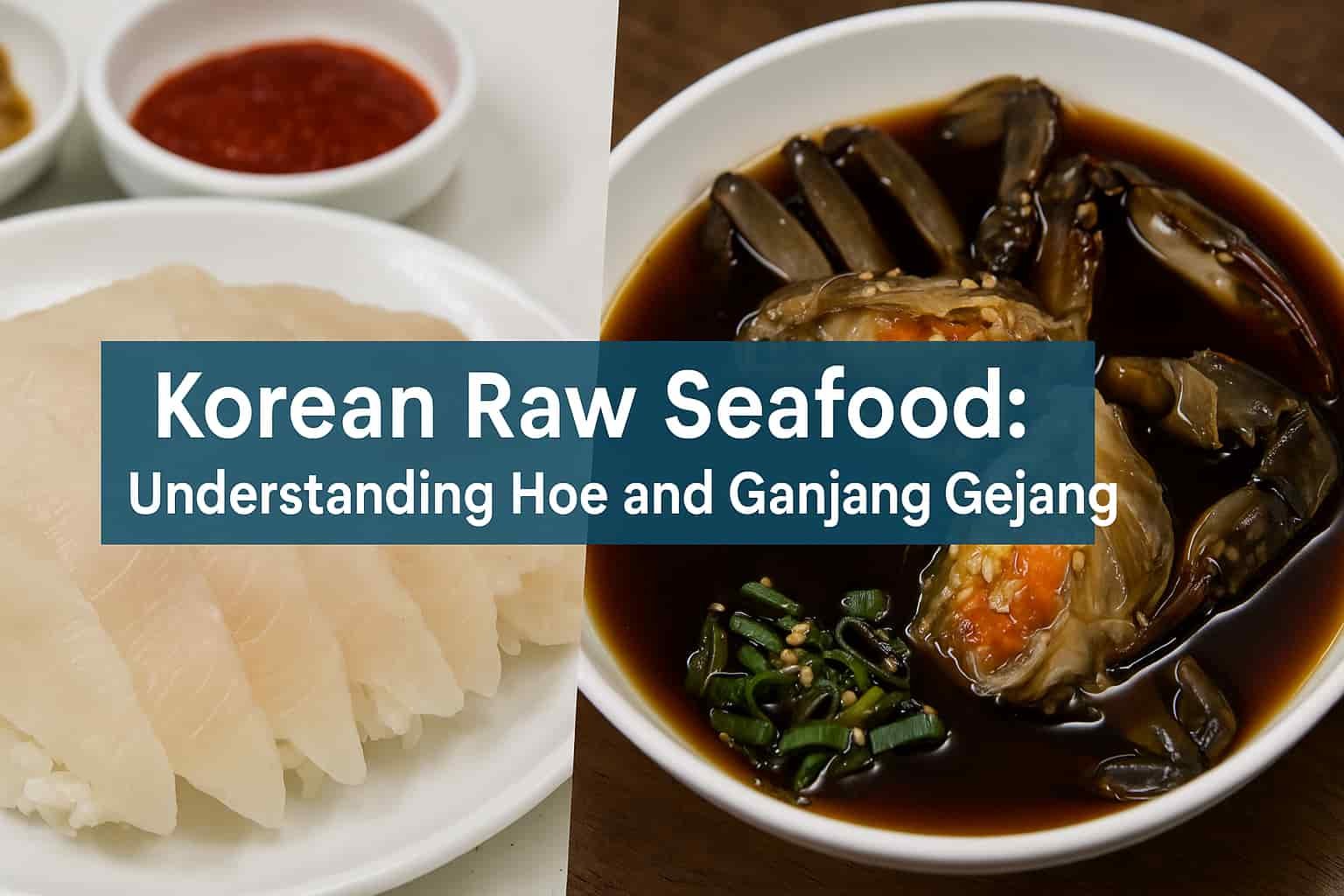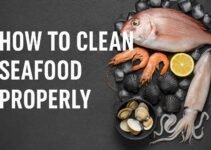Korean cuisine is renowned for its complex fermentation techniques, rich broths, and vibrant side dishes. Yet among these staples, raw seafood dishes like Hoe (회) and Ganjang Gejang (간장게장) hold a distinct cultural and culinary position. These two preparations represent the Korean approach to freshness, umami extraction, and minimal heat intervention. While Hoe refers to freshly sliced raw fish or seafood served with dipping sauces, Ganjang Gejang is raw crab marinated in a soy sauce base, often dubbed “rice thief” due to its intense flavor.
This article answers 8 key questions people commonly search about Korean raw seafood. It explains the types of seafood used, preparation methods, safety standards, places to eat, and health considerations. You will also discover how these dishes compare to Japanese sashimi and why they are globally admired. By the end, you will have a deep understanding of both Hoe and Ganjang Gejang—from ingredient sourcing to cultural relevance.
Contents
- 1 What Is Hoe in Korean Cuisine and How Is It Different from Sashimi?
- 2 What Is Ganjang Gejang and Why Is It Known as “Rice Thief” in Korea?
- 3 How Do Koreans Ensure Raw Seafood Safety in Hoe and Ganjang Gejang?
- 4 Where Can You Try Authentic Hoe and Ganjang Gejang in Korea?
- 5 How Should You Eat Hoe and Ganjang Gejang for the Best Experience?
- 6 Are There Any Health Risks Associated with Eating Korean Raw Seafood?
- 7 How Has Korean Raw Seafood Gained Popularity Globally?
- 8 What Are Some Related Korean Dishes That Also Use Raw Seafood?
What Is Hoe in Korean Cuisine and How Is It Different from Sashimi?
Hoe refers to raw seafood that is sliced and served with dipping sauces, typically cho-gochujang (vinegared red chili paste) or soy sauce with wasabi. Unlike Japanese sashimi, Hoe emphasizes freshness over aged flavor development. Korean chefs prioritize local catch, especially flatfish, rockfish, and squid, and slice it more thickly to preserve texture.
Sashimi, on the other hand, often involves aging fish for umami development and is cut with precision into thinner slices. In Hoe, texture and chewiness are considered desirable, while sashimi focuses on mouthfeel smoothness. The sauces differ as well—Korean diners rarely eat raw fish without a strong condiment, whereas sashimi is often eaten with minimal interference.
Which types of seafood are commonly used for making Hoe?
The most common seafood types used in Hoe include flatfish (광어), rockfish (우럭), squid (오징어), octopus (문어), abalone (전복), and sea cucumber (해삼). These ingredients are selected for their texture, freshness, and ability to retain flavor when eaten raw. In coastal cities like Busan and Jeju, seasonal catches like flounder and halibut are also widely served as Hoe.
Fish used in Hoe are often sourced within 12 hours of serving to guarantee optimal freshness. In specialized restaurants, tanks (수족관) hold live fish for on-the-spot preparation.
How is Korean-style slicing different from Japanese sashimi?
Korean Hoe is cut thicker and in larger pieces to highlight texture, while Japanese sashimi uses thinner, uniform cuts to emphasize elegance and flavor release. The goal of Hoe slicing is to preserve chewiness, particularly for species like octopus and flatfish, which Koreans value for their tactile satisfaction.
Knife techniques also differ. Korean chefs often use short, forceful cuts to segment fresh fish quickly, while Japanese chefs use long, fluid slicing motions that reduce friction and preserve the fish’s structure.
Why is dipping sauce essential when eating Hoe?
Dipping sauces in Hoe provide acidity, sweetness, and heat that balance the clean, often bland taste of raw fish. Cho-gochujang, made from gochujang, vinegar, and sugar, is the most widely used. It cuts through fish oiliness and enhances mouthfeel. Soy sauce with freshly grated wasabi or crushed garlic is another popular option.
Unlike sashimi, which emphasizes the fish alone, Hoe is eaten as a complete flavor combination—fish, sauce, perilla leaves, and sliced garlic or chili.
What Is Ganjang Gejang and Why Is It Known as “Rice Thief” in Korea?
Ganjang Gejang is a raw crab dish marinated in soy sauce, often called “rice thief” because its salty-sweet brine makes diners eat multiple bowls of rice. It uses female blue crabs filled with roe, soaked in a soy sauce marinade infused with ginger, garlic, onions, kelp, and sometimes fruit.
The name “rice thief” (밥도둑) originated from the dish’s umami intensity. When poured over hot rice, the marinade, crab roe, and soft flesh create a rich, addictive flavor profile. The dish is traditionally served cold and has been a part of Korean home cooking since the Joseon dynasty.
What kind of crab is used in traditional Ganjang Gejang?
Female blue crabs (꽃게) caught during spring and fall are preferred for Ganjang Gejang due to their high roe content and firmer texture. These crabs are typically harvested from the Yellow Sea, cleaned thoroughly, and immediately marinated.
The selection focuses on live crabs to ensure safety and flavor retention. Crabs with vibrant orange roe and a firm shell are indicators of freshness. Shell size ranges from 12 to 15 cm, and only hard-shell crabs are used to avoid internal breakdown during marination.
How is Ganjang Gejang marinated and preserved safely?
Crabs are cleaned, drained of internal fluids, and soaked in boiled and cooled soy sauce marinades with antimicrobial ingredients like garlic, ginger, and onions. The initial soak lasts 6–12 hours, after which the sauce is boiled again, cooled, and reused for a second marinade round to ensure safety.
Marination is done in sterilized glass containers stored at 0–4°C. Restaurants often serve Ganjang Gejang within 48 hours of preparation, while home versions can be refrigerated up to 5 days. The high salinity and acidity reduce microbial growth.
How Do Koreans Ensure Raw Seafood Safety in Hoe and Ganjang Gejang?
Koreans ensure safety in raw seafood dishes through regulated sourcing, microbial control via ingredients, and strict refrigeration protocols. Both Hoe and Ganjang Gejang involve seafood that is either served immediately after preparation or cured in antimicrobial marinades.
Government agencies like the Korea Food and Drug Administration (KFDA) regulate seafood safety standards for restaurants and suppliers. All seafood for raw consumption must be labeled 회용 (for raw use), and distributed with temperature tracking from catch to table.
What hygiene standards are applied in Korean seafood markets?
Seafood markets in Korea follow HACCP-certified protocols including continuous refrigeration, clean water circulation systems, and mandatory tank sanitation every 24–48 hours. Fish tanks are equipped with oxygen regulators, and crabs are held in separate enclosures to prevent cross-contamination.
Fishmongers are required to wear gloves and sanitize knives after each cutting session. Live seafood is typically transported in cold-chain vehicles maintaining temperatures between 0°C and 4°C.
How does salt, soy sauce, or acidity affect microbial safety?
Salt, soy sauce, and vinegar-based acids inhibit bacterial growth by lowering water activity (aw) and altering pH levels, making the environment hostile to pathogens. In Ganjang Gejang, soy sauce marinades achieve a salinity of 14–16%, which suppresses growth of Vibrio and Salmonella.
Ginger, garlic, and green onions—commonly added to marinades—contain natural antimicrobials like allicin and gingerol, which further protect against spoilage and pathogens. The pH of these marinades usually falls between 4.5 and 5.5, below the danger zone for microbial proliferation.
What is the shelf life of raw crab in soy sauce marinade?
Ganjang Gejang can be stored for up to 5 days in refrigeration at 0–4°C, but must be consumed within 48 hours once opened. Restaurants often prepare daily batches and discard leftovers at the end of service to avoid risk.
Homemade versions sometimes extend preservation to 7 days by boiling the soy marinade multiple times and adding high-salt ratios. However, the Korean Ministry of Food and Drug Safety recommends limiting home storage to 3 days for optimal food safety.
Where Can You Try Authentic Hoe and Ganjang Gejang in Korea?
Authentic Hoe and Ganjang Gejang can be found in coastal cities, seafood markets, and specialized raw seafood restaurants called 회전문점. These locations provide daily access to freshly caught seafood and prepare dishes on the spot.
Inland cities like Seoul also offer high-end versions of these dishes, but coastal regions provide more variety and freshness due to proximity to fishing harbors.
What are the best coastal cities for fresh raw seafood experiences?
Top coastal destinations for raw seafood include Busan, Jeju Island, and Yeosu. Busan’s Jagalchi Market, Korea’s largest fish market, offers live slicing stations for Hoe. Jeju’s coastal restaurants specialize in abalone and sea cucumber Hoe, harvested from volcanic coastlines.
In Yeosu, local markets serve fresh flower crab for Ganjang Gejang, particularly during spring and fall when roe is abundant. Each region also features local side dishes that complement their seafood, such as Jeju seaweed or Busan-style kimchi.
Are there restaurants specializing only in raw crab or sliced raw fish?
Yes, restaurants known as 회집 (Hoejip) and 간장게장전문점 (Ganjang Gejang specialist restaurants) serve exclusively raw seafood. Hoejip often display live tanks at their entrances and allow customers to select fish, which is sliced on demand.
Popular Ganjang Gejang chains like “Pro Soy Crab” in Seoul or “Jinmi Sikdang” in Mapo have operated for over 20 years and serve only soy-marinated crab, with rice refills provided for free—highlighting the dish’s “rice thief” status.
How Should You Eat Hoe and Ganjang Gejang for the Best Experience?
To enjoy Hoe and Ganjang Gejang fully, diners should combine them with traditional Korean side dishes, follow proper sequence in eating, and understand which parts are edible. Eating these dishes is not only about flavor but also about texture, temperature, and cultural context.
Both dishes are typically served in full set meals (정식, jeongsik), which include rice, soup, pickles, and sauces. Koreans value the interplay between spicy, sour, sweet, and savory—making condiments and accompaniments essential.
What are the side dishes (banchan) usually served with Hoe?
Hoe is typically served with 5–7 side dishes including cho-gochujang, pickled onions, garlic slices, perilla leaves, kimchi, and seaweed. These sides enhance the flavor of raw fish and offer contrasting textures.
For example:
- Perilla leaves are used to wrap slices of raw fish, creating a herbal note.
- Pickled onions help cleanse the palate between bites.
- Cold seaweed soup (미역국) is sometimes served to aid digestion.
Restaurants may also offer optional extras like fermented skate (hongeo) or cold raw fish soup (mulhoe), especially in coastal areas.
How do Koreans eat Ganjang Gejang with rice?
Koreans scoop the marinated crab flesh and roe directly onto rice, then mix it with marinade sauce and additional side dishes. A popular method is to press the crab shell against the rice bowl to extract every bit of meat and sauce.
The rice used is short-grain and slightly sticky, allowing it to absorb the soy-based marinade effectively. Some diners also mix in raw egg yolk or sesame oil to enrich the flavor.
A typical Ganjang Gejang meal includes:
- 1 whole marinated crab
- 1–2 bowls of rice
- Side dishes (kimchi, seasoned greens, dried anchovies)
- Doenjang soup or seaweed soup
Should foreigners eat raw crab shell or just the meat?
Only the meat, roe, and soft inner lining of the crab are eaten; the hard outer shell is not consumed. Foreign diners often ask whether the orange parts or jelly-like texture are safe—these are roe and crab innards, and they are traditionally prized for flavor.
Korean restaurants typically prepare Ganjang Gejang so that even first-time eaters can safely navigate which parts are edible. The shell acts as a serving vessel and flavor reservoir, not an edible component.
Are There Any Health Risks Associated with Eating Korean Raw Seafood?
Yes, raw seafood carries microbial risks such as Vibrio, Salmonella, and parasites, but these are minimized through hygiene, salting, and fermentation. Korean regulations require all seafood served raw to be certified and handled under cold-chain logistics.
However, certain populations—including pregnant women, the elderly, and those with weakened immune systems—are advised to avoid raw seafood altogether. For other raw seafood considerations, see our guide on Can You Eat Shrimp Raw?.
Who should avoid raw seafood like Hoe and Ganjang Gejang?
People with compromised immune systems, pregnant women, young children, and those with liver disease should avoid eating raw seafood. These groups are more vulnerable to foodborne pathogens like Listeria monocytogenes and Anisakis simplex.
The Korea Centers for Disease Control and Prevention (KCDC) advises these high-risk individuals to consume only fully cooked seafood. Additionally, those with shellfish allergies should avoid Ganjang Gejang.
What are the common foodborne pathogens in raw Korean dishes?
The most common pathogens associated with Korean raw seafood include Vibrio parahaemolyticus, Salmonella enterica, and Anisakis larvae. These organisms can cause symptoms ranging from mild gastrointestinal distress to severe infection.
For example:
- Vibrio thrives in warm seawater and can contaminate improperly handled fish.
- Anisakis is a parasitic nematode found in raw squid or mackerel, which can embed in the stomach lining if not removed.
- Salmonella contamination typically arises from poor handling rather than the seafood itself.
Freezing seafood at −20°C for 24 hours or longer kills most parasites.
How do you identify if raw seafood is not fresh?
Unfresh raw seafood has cloudy eyes, dull flesh, fishy odor, and a slimy texture. For crabs, a mushy shell or off-colored roe indicates spoilage.
Additional signs include:
- Dry or cracked gills in fish
- Soft abdomen in crabs
- Ammonia-like smell indicating bacterial activity
Restaurants specializing in raw seafood discard fish not consumed within 24–36 hours and perform regular odor, color, and texture checks as per HACCP guidelines.
How Has Korean Raw Seafood Gained Popularity Globally?
Korean raw seafood dishes like Hoe and Ganjang Gejang have expanded globally through Korean diaspora, K-drama influence, and the rise of K-Food in urban culinary scenes. These dishes are now featured in Korean restaurants across North America, Europe, and Southeast Asia.
For a global comparison of raw seafood customs, you can explore our article on Raw Scallops Around the World, which showcases raw scallop traditions from Japan to France.
The visual appeal of raw seafood dishes on social media platforms like Instagram, TikTok, and YouTube has also contributed to international curiosity and adoption. Food bloggers and chefs increasingly highlight Korean raw seafood as a unique alternative to sushi.
Which countries now serve Korean Hoe or Ganjang Gejang?
Korean raw seafood is served in over 40 countries, with strong presence in the U.S., Canada, Australia, Germany, and Vietnam. Major cities like Los Angeles, New York, and Toronto have dedicated Hoejip (raw fish houses) and restaurants offering Ganjang Gejang as part of premium Korean set meals.
In Southeast Asia, Korean food franchises have introduced these dishes to Bangkok, Jakarta, and Ho Chi Minh City. Some locations source local crab but maintain traditional marination methods to match Korean flavor profiles.
How is Korean-style raw seafood influencing international fusion cuisine?
Chefs worldwide are incorporating Korean raw seafood techniques into fusion dishes, blending marination methods with Western plating or regional ingredients. Examples include:
- Ganjang Gejang tartare with avocado puree in Michelin-starred restaurants
- Korean-style ceviche using cho-gochujang and perilla oil
- Hoe served as part of cold noodle salads or poke bowls
This hybridization makes Korean raw seafood more accessible while preserving its core culinary identity
What Are Some Related Korean Dishes That Also Use Raw Seafood?
Several other Korean dishes involve raw seafood, often with different preparation methods such as fermentation, spicy broths, or sesame-based sauces. These dishes reflect the diverse ways Koreans have historically preserved and consumed marine products without cooking.
Here are 4 examples of related raw seafood dishes:
- Yukhoe (육회): Raw beef served with julienned pear, sesame oil, pine nuts, and raw egg yolk. Sometimes includes raw seafood such as abalone.
- Hongeohoe (홍어회): Fermented skate with a strong ammonia smell, eaten with kimchi and pork. Considered an acquired taste.
- Mulhoe (물회): Spicy cold raw fish soup made with thinly sliced seafood, chili paste, vinegar, sugar, and iced broth. Popular in summer.
- Cho-ganjang Hoe (초간장회): Raw fish dipped in vinegar soy sauce, typically lighter and simpler than traditional Hoe, often eaten at home.
These related dishes provide further entry points into Korean raw seafood cuisine and serve as extensions for a potential topic cluster surrounding this article.



